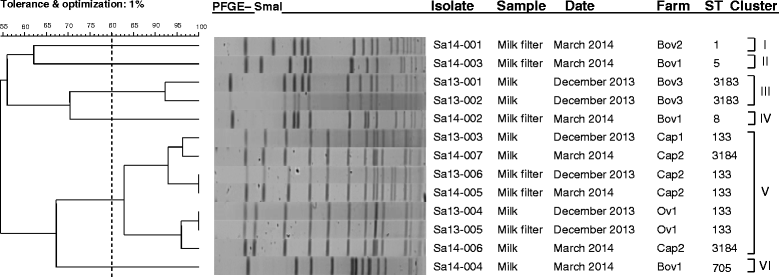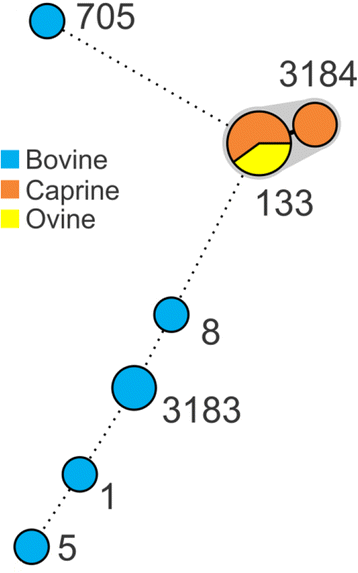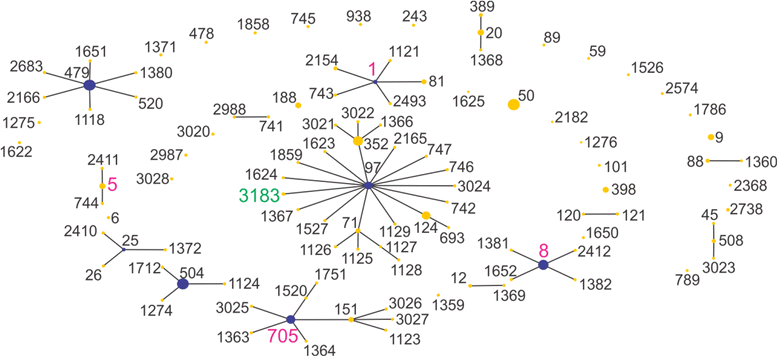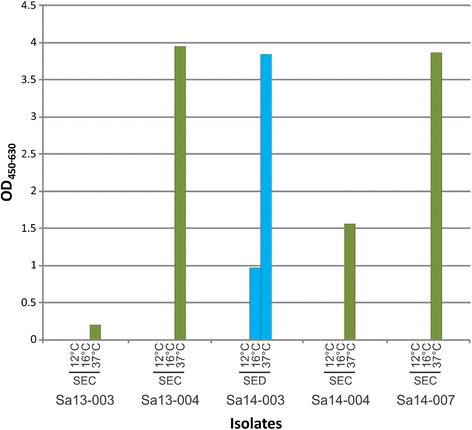Characterization of Staphylococcus aureus isolates from raw milk sources in Victoria, Australia
- PMID: 27473328
- PMCID: PMC4966798
- DOI: 10.1186/s12866-016-0789-1
Characterization of Staphylococcus aureus isolates from raw milk sources in Victoria, Australia
Abstract
Background: Highly pathogenic strains of Staphylococcus aureus can cause disease in both humans and animals. In animal species, including ruminants, S. aureus may cause severe or sub-clinical mastitis. Dairy animals with mastitis frequently shed S. aureus into the milk supply which can lead to food poisoning in humans. The aim of this study was to use genotypic and immunological methods to characterize S. aureus isolates from milk-related samples collected from 7 dairy farms across Victoria.
Results: A total of 30 S. aureus isolates were collected from milk and milk filter samples from 3 bovine, 3 caprine and 1 ovine dairy farms across Victoria, Australia. Pulsed Field Gel Electrophoresis (PFGE) identified 11 distinct pulsotypes among isolates; all caprine and ovine isolates shared greater than 80 % similarity regardless of source. Conversely, bovine isolates showed higher diversity. Multi-Locus Sequence Typing (MLST) identified 5 different sequence types (STs) among bovine isolates, associated with human or ruminant lineages. All caprine and ovine isolates were ST133, or a single allele variant of ST133. Two new novel STs were identified among isolates in this study (ST3183 and ST3184). With the exception of these 2 new STs, eBURST analysis predicted all other STs to be founding members of their associated clonal complexes (CCs). Analysis of genetic markers revealed a diverse range of classical staphylococcal enterotoxins (SE) among isolates, with 11 different SEs identified among bovine isolates, compared with just 2 among caprine and ovine isolates. None of the isolates contained mecA, or were resistant to oxacillin. The only antibiotic resistance identified was that of a single isolate resistant to penicillin; this isolate also contained the penicillin resistance gene blaZ. Production of SE was observed at 16 °C and/or 37 °C in milk, however no SE production was detected at 12 °C.
Conclusion: Although this study characterized a limited number of isolates, bovine-associated isolates showed higher genetic diversity than their caprine or ovine counterparts. This was also reflected in a more diverse SE repertoire among bovine isolates. Very little antibiotic resistance was identified among isolates in this study. These results suggest maintaining the milk cold chain will minimise any risk from SE production and highlights the need to prevent temperature abuse.
Keywords: Antibiotic sensitivity; Dairy farm; MLST; Milk; PFGE; Staphylococcal enterotoxin; Staphylococcus aureus.
Figures





References
-
- Brightling PMG, Malmo J, et al. Countdown. Werribee: Dairy Australia Limited; 2014. Countdown 2020: farm guidelines for mastitis control.
Publication types
MeSH terms
Substances
LinkOut - more resources
Full Text Sources
Other Literature Sources
Medical

